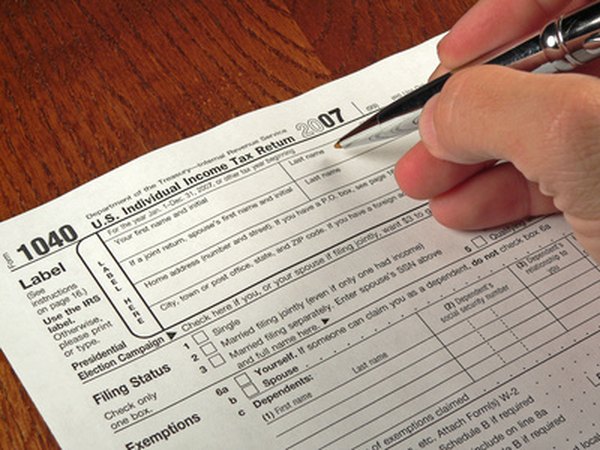Can I Claim a Loss on Stock Investments?
You have to use Form 1040 to report a capital loss.
tax forms image by Chad McDermott from Fotolia.com
If you made a bad stock investment and ended up losing money, you can use that loss to lower your taxes for the year. However, you can't claim the loss until you actually sell the stock. For example, just because the value of your portfolio went down, it doesn't entitle you to a deduction until you actually sell the stock.
Tip
You can't actually claim a loss on your stock investments until you sell them.
Stock Sale Loss Tax Deduction
When figuring your losses on individual stock investments, you subtract your gross proceeds from the sale from what you paid for the stock. When figuring what you paid, include the cost of any transaction fees or brokerage fees. For example, if you bought the stock for $900 and paid a $10 fee, your basis is $910. Similarly, when you figure your proceeds, don't count the portion that went to fees. If you later sell the stock for $720, but paid $10 in commissions, your proceeds are only $710, giving you a loss of $200.
You're limited to deducting a maximum of $3,000 of your losses per year, or $1,500 each if you're married but file separate returns. However, the limit is for net losses, which means that you first use your losses to offset any gains for the year. For example, say you had $15,000 in stock gains for the year and $25,000 in losses. You first offset your $15,000 of gains with $15,000 of losses, leaving you a net loss of $10,000; because of the limit, you can only claim a $3,000 deduction against your other income.
If you've held stocks for more than one year, you pay tax on any gains at the lower long term capital gains rate. If you've lost money on the stocks, you first deduct the long term capital loss from any long term capital gains, then from any short term capital gains, then from ordinary income.
How to Claim the Loss
When you file your taxes, you have to use Form 1040 to claim a stock sale loss tax deduction. However, you first have to compete Form 8949 to show your gains and losses on each stock you held during the year. Next, you have to complete Schedule D to show the offsetting of your capital gains with your capital losses.
Schedule D instructions may ask you to transfer certain Schedule D figures to Line 13 of 1040 Schedule 1 for calculating other income. After completing Schedule 1, transfer the amount from Line 22 to Line 6 of your 1040.
Excess Carryover Exceptions
If you have more losses than you're entitled to take in any given year, the IRS allows you to carry that capital loss deduction forward to future years. The IRS does not limit how many years into the future you can carry it over, but you must use as much of the deduction as you can each year.
For example, say you have a $7,000 loss carryover. The following year, if you have $2,000 in gains, you have to use $2,000 to offset the gains and $3,000 as a deduction, so you can only carry the last $2,000 over into the third year.
Writing Off Investment Losses in 2018
Overall rules around capital gains and losses aren't changing substantially in 2018, though the capital gains and ordinary income tax brackets are both changing. The rates for long term capital gains are still the same at 0, 15 percent or 20 percent, though the amount of capital gains you need to fall into a particular capital gains bracket is slightly higher. For ordinary income, tax rates are generally falling, meaning you may save less by writing off investment losses in 2018 than in previous years.
References
- Internal Revenue Service: Publication 550 (2017), Investment Income and Expenses
- Internal Revenue Service: Topic 409 - Capital Gains and Losses
- Fox Business: Stocks, Taxes and Profits: What You Need to Know in 2018
- Forbes: New: IRS Announces 2018 Tax Rates, Standard Deductions, Exemption Amounts And More
- IRS: 2018 Form 1040
- IRS: 2018 Schedule D
- IRS: Schedule 1
Resources
Writer Bio
Based in the Kansas City area, Mike specializes in personal finance and business topics. He has been writing since 2009 and has been published by "Quicken," "TurboTax," and "The Motley Fool."

